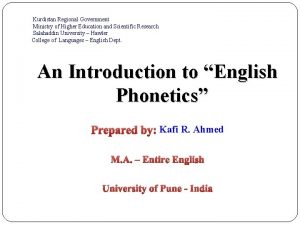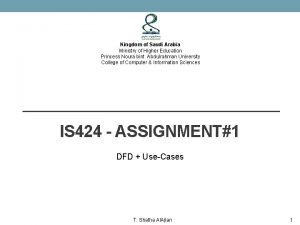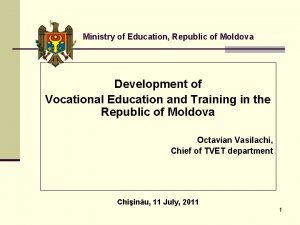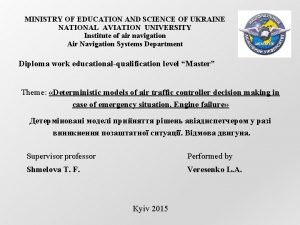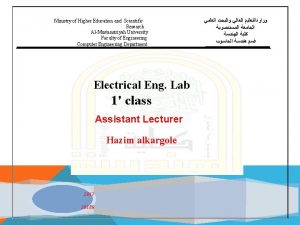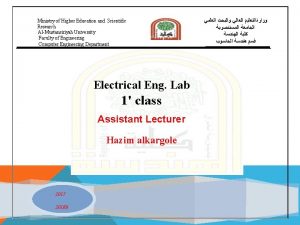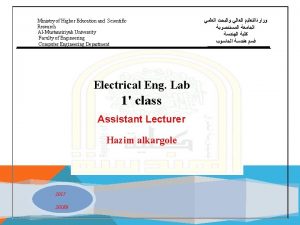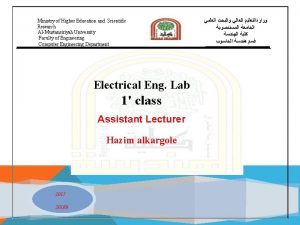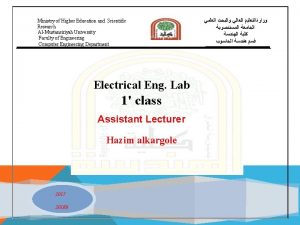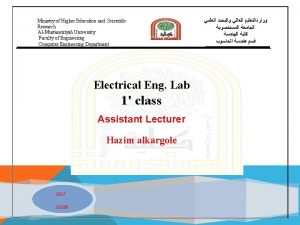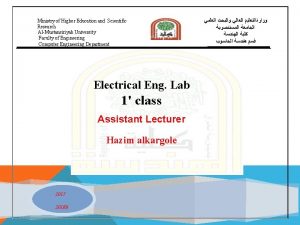Ministry of Higher Education and Scientific Research AlMustansiriyah


























- Slides: 26

Ministry of Higher Education and Scientific Research Al-Mustansiriyah University Faculty of Engineering Computer Engineering Department Electrical Eng. Lab 1' class Assistant Lecturer Hazim alkargole 2017 20189 ﻭﺯﺍﺭةﺎﻟﺘﻌﻠﻴﻢ ﺍﻟﻌﺎﻟﻲ ﻭﺍﻟﺒﺤﺚ ﺍﻟﻌﻠﻤﻲ ﺍﻟﺠﺎﻣﻌﺔ ﺍﻟﻤﺴﺘﻨﺼﺮﻳﺔ ﻛﻠﻴﺔ ﺍﻟﻬﻨﺪﺳﺔ ﻗﺴﻢ ﻫﻨﺪﺳﺔ ﺍﻟﺤﺎﺳﻮﺏ

CHAPTER (5) and Inductors Capacitors : A circuit element that is composed of two conducting plates or surfaces separated by a dielectric (non conducting) materials + A + C - circuit symbol

Let A : surface area of each plate d : distance between the two plates Capacitance As Area Capacitance As distance C A d It is found that ε 0 A C d Where : ε 0 Permittivity of free space

ε 0 8. 85 *10 12 F m • If a voltage source (v) is connected to the capacitor , +ve charge will be transferred to one plate while –ve charge will be transferred to the other plate. Let the charge stored at the capacitor q If v , q v q It has been found that q cv

C is the capacitance CQ V Current in capacitor : We know that i(t) d q(t) dt i c (t) d c v c (t) dt dv c (t) i c (t) C dt

Voltage of capacitors dv c (t) Q i c (t) C dt i c (t) dt C dvc (t) d v c (t) 1 i c (t)dt C 1 v c (t) v c (t 0) C Where t 0 : initial time τ t i (τ ) dτ c τ t 0

NOTE : Capacitors only store and release ELECTROSTATIC energy. They do not “creat e” The capacitor is a passive element and follows the passive sign convention Linear capacitor circuit representation i(t) C dv (t) dt

Power of the capacitors : Pc (t) vc (t) ic (t) Pc (t) v c (t) C dv c (t) dv (t) C vc (t) c dt dt or 1 Pc (t) i c (t) v c (t 0 ) C i c τ dτ τ t 0 τ t

Energy of capacitor w c (t) τ t P τ dτ c τ dv c τ dτ C v c τ dτ τ τ t vc (t) C v τ dv τ c c vc ( ) v c (t) 2 1 C v c τ | v (- ) c 2 2 2 1 1 C v c t C v c 2 2

Assuming V C 0 1 w c (t) C v c 2 (t) 2 q (t) v c (t) C 1 q 2 (t) w (t) C c 2 C 2 1 2 w c t q (t) 2 C

EXAM PLE: The following voltage is imposed across the terminals of a 0. 5 F capacitor. 0 V , t 0 v c (t) 4 t V , 0 t 1 4 e t 1 V, 1 t v (t) 4 1 2 3 t

Find the following: 1. ic(t) 2. Pc(t) 3. wc(t) dv c (t) (1) i c (t) C dt 0 d i c t C 4 t 4 C 2 µ A dt d t 1 (t 1) 4 e 4 C 1 e 2 e µA C dt t 0 0 t 1 1 t

i C (t) 2 µA t - 2µ A (2) dv c (t) Pc(t) C vc (t) dt 0. 5µ F 0 dv c t 0 W dt 0. 5µ F 4 t 4 8 t µW 0. 5µ F 4 e t 1 8 e 2 t 1 t 0 0 t 1 µW 1 t

P C a. Charging b s o r b e d. Power power 8µ A 1 t -8µ A (3) s. Discharging u p p l i e d p o. Power 1 2 C v c (t) 2 0 1 2 w c (t) 0. 5µ F 4 t 2 µJ 2 1 0. 5µ F 4 e t 1 2 4 e 2 t 1 2 w c (t) t 0 0 t 1 µJ 1 t

w C (t) 4 µJ 4 e 2 (t 1) 4 t 2 1 t Example : The voltage at the terminals of a 0. 5 F capacitor is 0 vc (t) 20000 t sin(40000 t) V 100 e t 0

Find: 1. i(0) 2. Power delivered to the capacitors at t = m S. 3. Energy stored in the capacitor at t = 80 m S i (t) C dv c (t) dt

C D 100 E 20, 000 T dt SIN 40, 000 T C 100 e 20, 000 t cos (40, 000 t)(40, 000) sin(40, 000 t) ( 2 *106 e 20, 000 t ) i c (0) 0. 5 *10 6 100 (1) (40, 000) 0 i c (0) 2 A (2) Π m P Find C 80 ? dv c (t) Pc (t) C v c (t) , t 0 dt 0. 5µ F 100 e 20, 000 t sin 40, 000 t * 100 e 20, 000 t cos (40, 000 t) (40, 000) sin (40, 000 t) ( 2 *106 e 20, 000 t )

Π PC ( m) 20. 79 W 80 (3) Find WC (t) Π m) 80 (discharging) ? 2 1 1 C v C 2 (t) C 100 e 20, 000 t sin (40, 000 t) 2 2 Π WC ( m) 519. 2 µ J 80

INDUCTO RS : Inductors are circuit elements that consist of a conducting wire in the shape of a coil Circuit representation for an inductor

• If a current is flowing in the inductor, it produce a magnetic field , (T) • The direction of ( depends on the right-hand rule. LI(T) Where L is the inductance and measured in Henry [H] • As the current increases or decreases, the magnetic field spreads or collapse • The change in magnetic field induces a voltage across the inductor. d (t) VL (t) dt di L (t) VL (t) L dt

Current in inductors : di L (t) v L (t) L dt 1 di L (t) v L (t) dt L Integrate both sides as before 1 i L (t) i L (t 0 ) L τ t v τ dτ τ t 0


Power in inductor : PL (t) v L (t) i L (t) di L (t) L dt di L (t) PL (t) L i L (t) dt τ t 1 v τ dτ PL (t) v L (t) i L (t 0 ) L τ t 0

Energy in inductors: τ t W L (T) P Τ DΤ L τ τ t L i L τ τ di L τ dτ dτ As before w L (t) 1 Li 2 2 L (t)

Example : The current flow through an 100 m H inductor 0 A i. L (t) 5 t 10 t e t 0 A Find : (1) Maximum value of current. (2) v. L(t) , (3) PL(t) , (4) w. L(t) i. L(t) First, find t max di (t) let L 0 i. L(max) dt 10 t 5 e 5 t 10 0 e 5 t 50 t 10 0 tmax 0. 2 sec t max t

i. Lmax I L 0. 2 10 0. 2 E 5 0. 2 2 e 1 0. 736 A (2) di L (t) v L (t) L dt d 0. 1 H 10 t e 5 t dt 0. 1 e 5 t 50 t 10 e 5 t 1 5 t , t 0 0 v L (t) 5 t e (1 5 t) , t 0
 Ministry of higher education afghanistan
Ministry of higher education afghanistan Ministry of education krg
Ministry of education krg Krg ministry of higher education
Krg ministry of higher education Kurdistan
Kurdistan Ministry of higher education saudi arabia
Ministry of higher education saudi arabia Face application
Face application Ministry of higher education tunisia
Ministry of higher education tunisia Ministry of higher education saudi
Ministry of higher education saudi Ministry of education romania
Ministry of education romania Ministry of education romania
Ministry of education romania Ministry of education and culture cyprus
Ministry of education and culture cyprus Hellenic ministry of education and religious affairs
Hellenic ministry of education and religious affairs Ministry of education and science of the russian federation
Ministry of education and science of the russian federation Ministry of education serbia
Ministry of education serbia What is textbook
What is textbook Matriculation certificate
Matriculation certificate Ministry of education armenia
Ministry of education armenia Ministry of education
Ministry of education Ministry of education iceland
Ministry of education iceland Ministry of education morocco
Ministry of education morocco Ministry of education
Ministry of education Ministry of education
Ministry of education Ministry of education peru
Ministry of education peru Ministry of education secondary engagement program
Ministry of education secondary engagement program Ministry of education
Ministry of education Ministry of education
Ministry of education Ministry of national education romania
Ministry of national education romania


